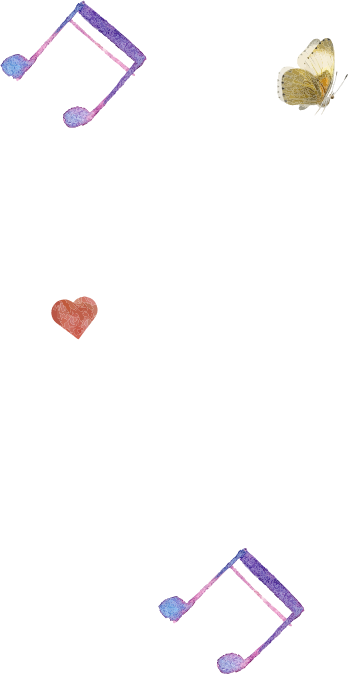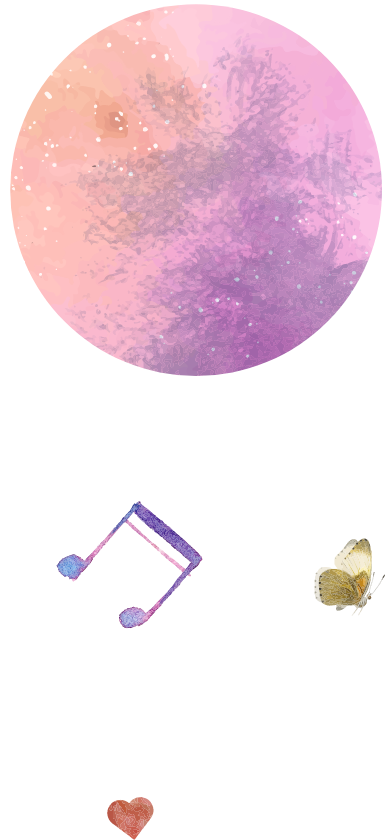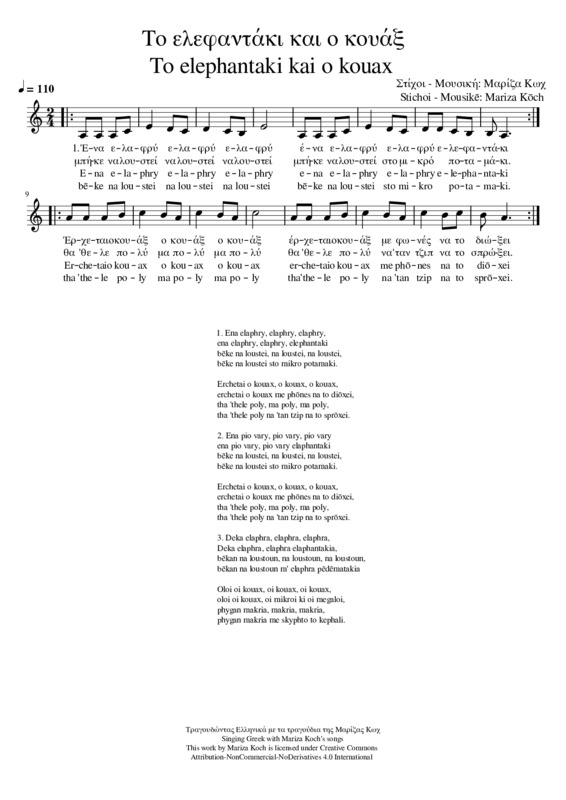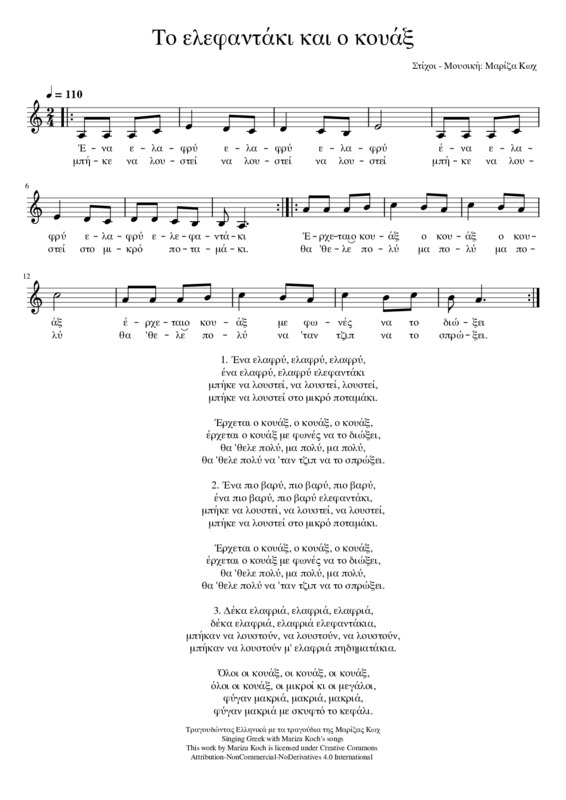
To elephantaki kai o kouax

To elephantaki kai o kouax
Pronunciation
Articulation of the consonant clusters /στ/ (st), /σπρ/ (spr) και /φρ/ (phr) and their use in the Greek language [λουστεί (loustei, to wash his hair), σπρώξει (sprōxei, to push), ελαφρύ (elaphry, light)]. Continue by practicing other clusters, such as /στρ/ (str), /σκ/ (sk), /σφ/ (sph), etc. [στρώνω (strōnō, set {e.g. the table), σκαρφίζομαι (skarphizomai, to come up with), σφυρίζω (sphyrizō, to whistle), etc.].
Speech Comprehension and Production
Opposite adjectives referring to size: light - heavy, little - big, tall, short, wide - narrow, etc.
Various degrees of adjectives: positive, comparative, superlative which are usually expressed either by adding suffixes to the original word (varys, varyteros, barytatos - heavy, heavier, heaviest), or descriptively (varys, pio varys, o pio varys - heavy, more heavy, the most heavy), etc.
Conditional tense (to bath, to push, to send away).
Analysis of content and discussion over the "other" that claims our space (e.g. the little elephant comes and uses the stream where the frogs live). Turn the poem into a story with a narration line initially for two characters (elephant and frog) moving on to having two groups reenact the story.
The students may decide to put a different ending to the story (creative writing practice solo or in groups and/ or role play).
Various degrees of adjectives: positive, comparative, superlative which are usually expressed either by adding suffixes to the original word (varys, varyteros, barytatos - heavy, heavier, heaviest), or descriptively (varys, pio varys, o pio varys - heavy, more heavy, the most heavy), etc.
Conditional tense (to bath, to push, to send away).
Analysis of content and discussion over the "other" that claims our space (e.g. the little elephant comes and uses the stream where the frogs live). Turn the poem into a story with a narration line initially for two characters (elephant and frog) moving on to having two groups reenact the story.
The students may decide to put a different ending to the story (creative writing practice solo or in groups and/ or role play).
Music Activities
Solfége on air indicating the changes of the pitch following the rhythm in order to learn the melody of the song.
Song with mimetic movements.
The pupils walk in rhythm alternating their gait between the elephant's light steps to the elephant's heavier steps, and to the frog's angry response.
Accompany the song with clapping to the rhythm of the meter and the song melody or with body percussion following the content of the text (e.g. the pupils render the light elephant with gentle body percussion, the heaviest elephant with louder body movements, and the ten light elephants with gentle loud movements).
Divide the pupils into two groups (elephants and frogs), who have a dialogue with the accompaniment of musical instruments or with body percussion, rendering the characters and the emotions of the animals (the calm elephant and the angry frog, the calm elephants taking their bath in the lake and the frogs that leave defeated with their heads bowed).
Sound images in relation to the soundscape of the river where the song unfolds. The pupils discuss and are asked to describe the surroundings of the environment (birds, insects, water, other animals, etc.).
Listen to the excerpt "The elephant" from “The Carnival of the Animals” by Saint-Saëns, the pupils render the weight of the elephant while walking.
Song with mimetic movements.
The pupils walk in rhythm alternating their gait between the elephant's light steps to the elephant's heavier steps, and to the frog's angry response.
Accompany the song with clapping to the rhythm of the meter and the song melody or with body percussion following the content of the text (e.g. the pupils render the light elephant with gentle body percussion, the heaviest elephant with louder body movements, and the ten light elephants with gentle loud movements).
Divide the pupils into two groups (elephants and frogs), who have a dialogue with the accompaniment of musical instruments or with body percussion, rendering the characters and the emotions of the animals (the calm elephant and the angry frog, the calm elephants taking their bath in the lake and the frogs that leave defeated with their heads bowed).
Sound images in relation to the soundscape of the river where the song unfolds. The pupils discuss and are asked to describe the surroundings of the environment (birds, insects, water, other animals, etc.).
Listen to the excerpt "The elephant" from “The Carnival of the Animals” by Saint-Saëns, the pupils render the weight of the elephant while walking.
Cross-thematic Connections - Greek Culture
Interdisciplinary concept: interaction.
Lake and river ecosystems starting from the environment described in the song (river probably in an African or Asian country). Discussion on what else the ecosystem may include (insects, birds, nature, fish, invertebrates, microorganisms, etc.). View of audiovisual material related to African and Asian elephant (identify similarities and differences), and frog species.
Free depiction of the environment and the history of the song (depending on the age of the pupils) through group painting and / or collage.
Starting with the treatment of the “foreign” elephant in the song, discuss the role of the “foreigner” in a social environment and the possible reactions that its presence may provoke. Proposed solutions for the harmonious coexistence of people.
Lake and river ecosystems starting from the environment described in the song (river probably in an African or Asian country). Discussion on what else the ecosystem may include (insects, birds, nature, fish, invertebrates, microorganisms, etc.). View of audiovisual material related to African and Asian elephant (identify similarities and differences), and frog species.
Free depiction of the environment and the history of the song (depending on the age of the pupils) through group painting and / or collage.
Starting with the treatment of the “foreign” elephant in the song, discuss the role of the “foreigner” in a social environment and the possible reactions that its presence may provoke. Proposed solutions for the harmonious coexistence of people.
Age level
3-7 years old
7-11 years old
Language level
Beginner
Unpublished





